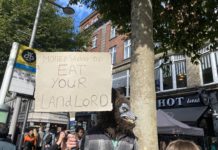Brian McDermott looks into symbols of politics and the politics of symbols in Northern Ireland.
Richard Haas and Meghan O’Sullivan concluded their discussions on Flags, Parades and the Past with the presentation of their report at year’s end 2013. They had spent over six months in meetings, discussions, plenary sessions and one-to-one briefing sessions, but failed to secure a substantive agreement.Haass and O’Sullivan are no lightweights.
In diplomatic, political and academic circles they are considered to have extremely impressive CVs, and they were invited to address the issue by the First and Deputy First Ministers.
On flags and emblems Haass and O’Sullivan pursued three approaches. They explored the issues around the flying of flags on public buildings, the ‘unofficial’ flying of flags on lampposts, main roads and in housing estates, and, thirdly, a proposal to design a completely new flag for Northern Ireland ‘honouring the shared history of the people of Northern Ireland’.
Ultimately no consensus was achieved by the parties in the Executive.
Given the international input, the protracted discussions and the necessity to pursue these issues post-Haass, a number of aspects deserve closer examination: not least the importance ascribed to signs and symbols in Northern Ireland.
The hostility around flags and parades is indicative of a number of problems caused by seismic shifts in both unionist and nationalist politics in Northern Ireland.
For generations, unionism was defined by a simplistic philosophy of ‘what we have we hold’. By and large, political unionism delivered on that for its followers. In mirror image, Sinn Féin’s opposition to Northern Ireland (its spokespersons manage to never use that phrase) was absolute, with a mantra of ‘Brits Out’, ‘Smash Stormont’ ‘no truck with police’ and ‘32 Counties or nothing’.
With the rise of new types of unionist and nationalist parties came the difficulties of explaining those changes to their supporters.
Flags and emblems continue to act as a tribal shorthand; to mark territory, intimidate and secure division.
For DUP and traditional working class unionist voters, ‘What we have’ was clearly being given away, to their sworn enemy into the bargain. For many nationalists, it was too much to see Sinn Féin in a Northern Ireland government, sitting on policing boards, working with the very people they had expected to be expelled from the country, with no sign of the promised united Ireland.
Sinn Féin and the DUP’s middle class supporters – and they are increasing all the time – are much more pragmatic than their working class cousins. As yesterday’s disillusioned supporters cling to the symbols of the past, the new all-class alliance at Stormont seeks to move on while going through the motions of tacit support.
The Unionist Forum, created to act as a focal point for unionist concerns over flags and emblems, has since withered on the vine. Sinn Féin opposition to ‘contentious parades’, a key element in their 1990s strategy has dissipated considerably, but remains the mainstay of dissidents and disaffected Provos.
Yet flags and emblems continue to act as a tribal shorthand; to mark territory, intimidate and secure division. The same functions are performed by football shirts, passports and languages too, with the manufactured tensions between Irish and Ulster Scots. The DUP, Sinn Féin and others still happily use symbols and imagery to keep in touch with their bases, but they are also happy to distance themselves from flag protestors and parade demonstrators.
The majority of middle class nationalists and unionists are happy to get on with life largely unaffected by flags on lampposts, pictures on gable walls and overt and contentious signs of the ‘two communities’.
There are however two notable exceptions. When flag protests threaten to impact on Belfast city centre retailing and when cyclists come to town.
A number of parties in the Assembly are seeking legislation to remove all election posters, paramilitary murals and flags for two days in May when the Giro d’Italia cycle race comes to Northern Ireland. It’s a bit like having a strange relative living at home and putting him under the stairs until the visitors have gone.
During January, another symbol was unveiled on the Shankill Road. It was the flag of the Spanish Republic and formed part of the commemorative plaque dedicated to the memory of seven men from the Shankill who left for Spain and joined the International Brigades in 1936. Those who gathered for the event were clear that they represented what one called ‘Belfast’s proud radical tradition’. The flag wavers of unionism and nationalism, and those who depend on them for votes, have a long way to go to be part of their city’s radical tradition. It takes more than banners and bunting.
Brian McDermott is a Workers’ Party activist.





